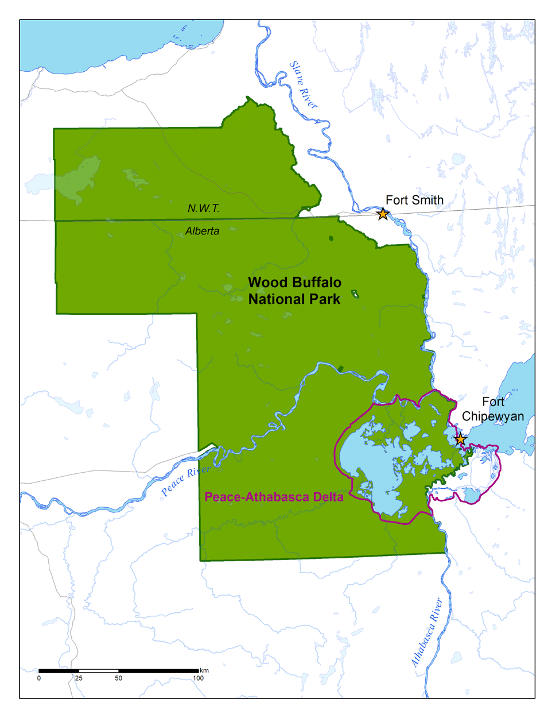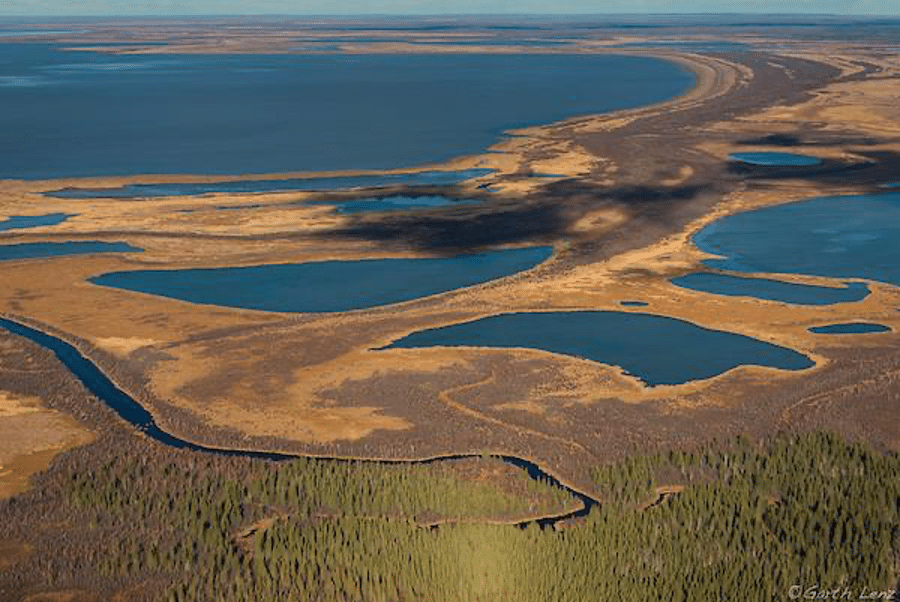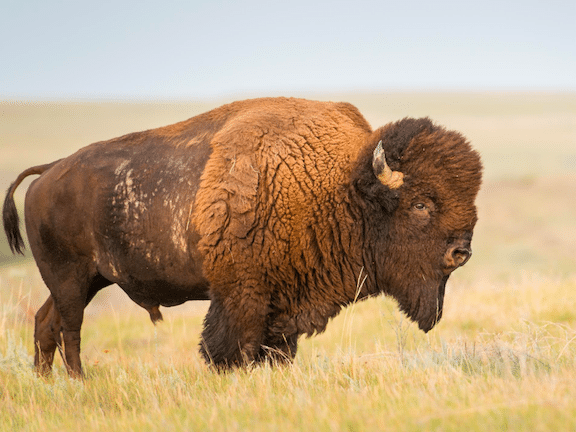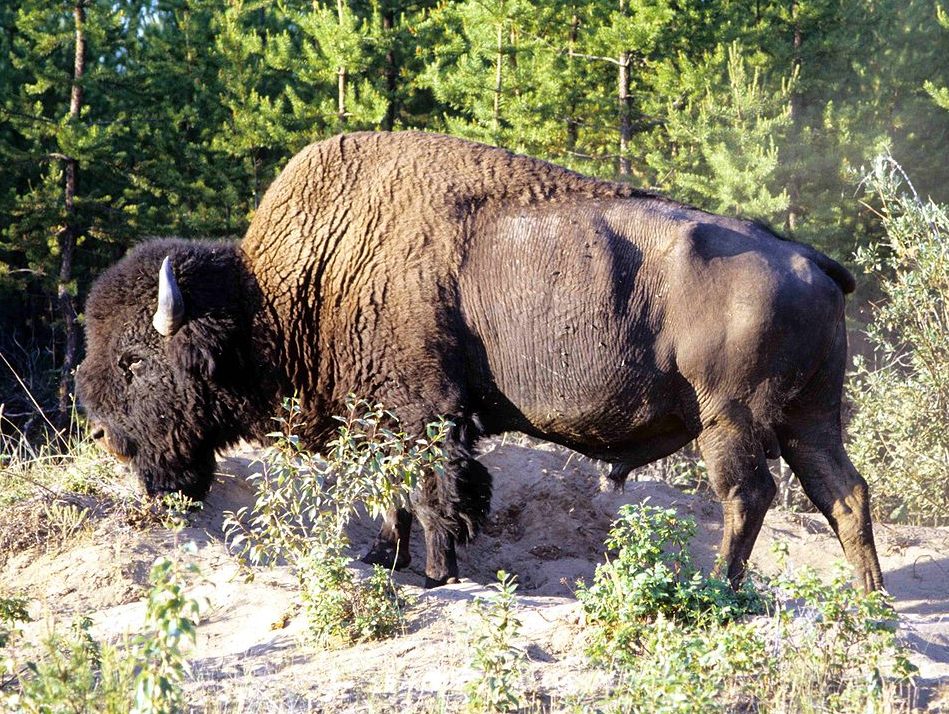A Brief Indigenous History of Wood Buffalo National Park
Published [post_published]
Gillian Chow-Fraser
This blog post is the first in a series of blogs highlighting the importance of Wood Buffalo National Park in northern Alberta to Indigenous peoples and their leadership in saving it.

Wood Buffalo National Park is Canada’s largest national park, capturing almost 4.5 million hectares of boreal plains in northern Alberta and the Northwest Territories. Known for its incredible wealth of natural phenomena, its lands and waters were first stewarded by Indigenous peoples that depended on the area to sustain their communities for thousands of years before European colonization.
The region captures the joining of two major rivers: the Peace and Athabasca. These rivers acted as major travel and trade corridors. The Peace-Athabasca Delta is a centre of social, economic, cultural, spiritual, and political activities for many Indigenous communities.
The area currently known as Wood Buffalo captures many traditional territories. Cree, Dene, and Métis used these lands and waters–and still depend on the area–to maintain their culture, spirituality, and livelihoods.

Satellite imagery of Lake Claire in the Peace-Athabasca Delta, made up of wetlands, perched basins, meandering streams, and diverse wildlife.
A Troubled History: Keeping Bison in and Indigenous Peoples out
European fur traders first arrived in the Delta in the late 1700s, driving a new direction for the economy of the region. The fur trade brought with it an influx of non-Indigenous settlers and led to the creation of Fort Chipewyan and Fort Smith, which continue to be important settlements for Cree and Dene First Nations, and Métis communities today.
In 1899, Treaty 8 was signed and extinguished Indigenous land claims in the area, ceding the land to the federal government. It was supposed to provide assurances to First Nations of their right to access their traditional territories, including what eventually became Wood Buffalo National Park. First Nations in this area still have to consistently fight to have their Treaty Rights upheld.
Wood Buffalo National Park was created in 1922. Shortly after this, Métis families were forcibly removed and excluded from activities in the Park.

As you may have guessed from its name, the Park was created to protect dwindling wood bison herds. Both wood bison and plains bison were hunted to near-extinction across North America after European colonization, despite previous generations of sustainable harvests by Indigenous peoples. The bison decline negatively impacted Indigenous people that have depended on bison harvests for their economies and sustenance, and had deep connections to the herds.
However, Indigenous access to the bison in the Park was strongly restricted and exclusionary. Perhaps one of the greatest tragedies of its history is that Wood Buffalo National Park was created to conserve the bison, but did so at the expense of Indigenous peoples who had sustainably managed the animals for millenia.


Left: Plains bison (Canva). Right: Wood bison (Ansgar Walk, CC BY-SA 2.5)
How can you tell the difference between a wood bison and a plains bison? Wood bison tend to have a taller build with a square hump. They tend to be darker in colour with little to no chap hair on their legs. Conversely, plains bison are stockier with a rounded hump, lighter in colour, with chaps of long hair on their forelegs. You can spot both plains and wood bison near Edmonton, at Elk Island National Park!
Who Can Access the Wood Buffalo National Park? A Legacy of Tensions and Conflicts
Parks Canada first made attempts to reconcile the dispossession of Indigenous peoples from this area by allowing First Nations to carry out traditional harvests within its boundaries. However, exclusionary rules meant that those with long-standing family ties to the area, but who did not live in the Park when it was created, were not considered eligible to participate in the harvests.
The minutiae of the government rules that dictated who could access and harvest in the Park led to divisions among Indigenous communities that never existed before.
It wasn’t until 2005 that the Mikisew Cree First Nation, whose traditional territory extends into Wood Buffalo, won a legal battle against the federal government at the Supreme Court of Canada to recognize that First Nations had Treaty rights to hunt, fish, and trap within the Park, regardless of the Park’s restrictive rules. Since then, they now also recognize the asserted Rights of the Métis to use the Park for their traditional activities.
These tensions and conflicts still echo throughout the communities to this day.

Wood Buffalo National Park Now: A Park in Need of Saving
Since the creation of Wood Buffalo National Park, the health of the Peace-Athabasca Delta has dramatically declined. Indigenous communities see these declines firsthand: the drying of the Delta, the disappearance of culturally important animals and plants, the slow pollution of the fish, waters and air.
Indigenous communities find themselves downstream of the oil sands, massive hydroelectric dams and the proposed Site C dam. They understand that Wood Buffalo’s ecological integrity has not always been a priority for the provincial and federal governments. And still, they fight the most for what they have lost: healthy waters, clean air, thriving wildlife, and their homes.
In our next blog post in this series, we will explore the causes of Wood Buffalo National Park’s degrading health and the Indigenous communities that are leading the fight to save it.
What to learn more about Wood Buffalo National Park and the Indigenous communities that depend on it? Check out these resources:
- CPAWS NAB Wood Buffalo National Park page
- Mikisew Cree First Nation petition to UNESCO to list Wood Buffalo National Park as a World Heritage Site in Danger
- Video about the Métis of Wood Buffalo National Park
- The Northwest Territory Métis Nation’s document on Wood Buffalo National Park: Silence on the Truth of the Métis Experience
- COSEWIC Report on Plains Bison and Wood Bison
Take Action
Share your support for National Urban Parks
Email your MLA to let them know you support National Urban Parks and would like to see Alberta be a part of a national network of urban parks.
STAY INFORMED
Protect the Wilderness
To receive news and updates from CPAWS Northern Alberta, including opportunities to get involved, join our mailing list below.
